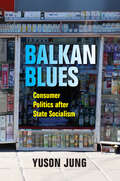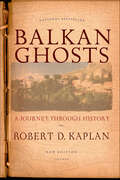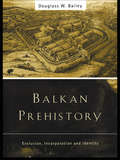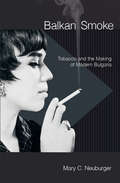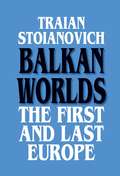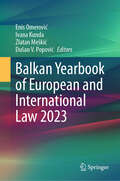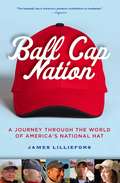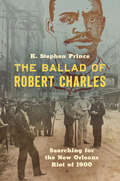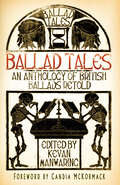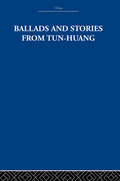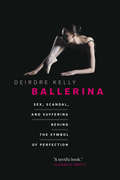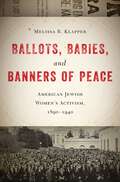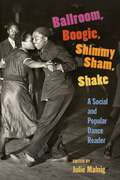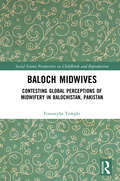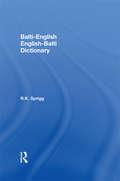- Table View
- List View
Balkan Blues: Consumer Politics after State Socialism (New Anthropologies of Europe)
by Yuson JungAn exploration of how a state transitions from the collectivized production and distribution of socialism to the consumer-focused culture of capitalism.In Balkan Blues, Yuson Jung considers the state as an economic agent in upholding rights and responsibilities in the shift to a global market. Taking Bulgaria as her focus, Jung shows how impoverished Bulgarians developed a consumer-oriented society and how the concept of “need’ adapted in surprising ways to accommodate this new culture.Different legal frameworks arose to ensure the rights of vulnerable or deceived consumers. Consumer advocacy NGOs and government officers scrambled to navigate unfamiliar EU-imposed models for consumer affairs departments. All of these changes involved issues of responsibility, accountability, and civic engagement, which brought Bulgarians new ways of viewing both their identities and their sense of agency. Yet these opportunities also raised questions of inequality, injustice, and social stratification. Jung’s study provides a compelling argument for reconsidering of the role of the state in the construction of twenty-first-century consumer cultures.“A good contribution to post-socialist and Balkan studies, showing well that the concept of post-socialism can still be useful not only in the context of Central and Eastern Europe, but also in the Balkans. The book is based on long-term, deep ethnography and is well written . . . I recommend it to anyone who wants to try to understand social, political, and economic differences in Europe and everyday practices related to the (imaginaries of the) state.” —Karolina Bielenin-Lenczowska, Ethnologia Polona
Balkan Dialogues: Negotiating Identity between Prehistory and the Present (Routledge Studies in Archaeology)
by Maja Gori Maria IvanovaSpatial variation and patterning in the distribution of artefacts are topics of fundamental significance in Balkan archaeology. For decades, archaeologists have classified spatial clusters of artefacts into discrete “cultures”, which have been conventionally treated as bound entities and equated with past social or ethnic groups. This timely volume fulfils the need for an up-to-date and theoretically informed dialogue on group identity in Balkan prehistory. Thirteen case studies covering the beginning of the Neolithic to the Middle Bronze Age and written by archaeologists conducting fieldwork in the region, as well as by ethnologists with a research focus on material culture and identity, provide a robust foundation for exploring these issues. Bringing together the latest research, with a particular intentional focus on the central and western Balkans, this collection offers original perspectives on Balkan prehistory with relevance to the neighbouring regions of Eastern and Central Europe, the Mediterranean and Anatolia. Balkan Dialogues challenges long-established interpretations in the field and provides a new, contextualised reading of the archaeological record of this region.
Balkan Ghosts: A Journey Through History
by Robert D. KaplanA new edition of the classic travelogue exploring the Balkan Peninsula’s political, social, religious, and economic past.From the assassination that triggered World War I to the ethnic warfare in Serbia, Bosnia, and Croatia, the Balkans have been the crucible of the twentieth century, the place where terrorism and genocide first became tools of policy. Chosen as one of the Best Books of the Year by the New York Times, and greeted with critical acclaim as “the most insightful and timely work on the Balkans to date” (Boston Globe), Kaplan’s prescient, enthralling, and often chilling political travelogue is already a modern classic.This new edition of Balkan Ghosts includes six opinion pieces written by Robert Kaplan about the Balkans between 1996 and 2000, beginning just after the implementation of the Dayton Peace Accords and ending after the conclusion of the Kosovo war, with the removal of Slobodan Milosevic from power.Praise for Balkan Ghosts“The product of over a decade of travel and research, this is one of precious few works that allows a Western reader a look into the tortured soul of the Balkan peoples. . . . A superior narrative. . . . Kaplan is a master of this genre.” —Library Journal“A memorable portrait of an increasingly important region.” —Kirkus Review
Balkan Prehistory: Exclusion, Incorporation and Identity
by Douglass W. BaileyDouglass Bailey's volume fills the huge gap that existed for a comprehensive synthesis, in English, of the archaeology of the Balkans between 6,500 and 2,000 BC; much research on the prehistory of Eastern Europe was inaccessible to a western audience before now, because of linguistic barriers. Bailey argues against traditional interpretations of the period, which focus on the origins of agriculture and animal breeding. He demonstrates that this was a period when monumental social and material changes occurred in the lives of the people in this region, with new technologies and ways of displaying identity. Balkan Prehistory will be required reading for everyone studying the Neolithic, Copper and early Bronze Ages of Eastern Europe.
Balkan Smoke: Tobacco and the Making of Modern Bulgaria
by Mary C. NeuburgerIn Balkan Smoke, Mary Neuburger leads readers along the Bulgarian-Ottoman caravan routes and into the coffeehouses of Istanbul and Sofia. She reveals how a remote country was drawn into global economic networks through tobacco production and consumption and in the process became modern. In writing the life of tobacco in Bulgaria from the late Ottoman period through the years of Communist rule, Neuburger gives us much more than the cultural history of a commodity; she provides a fresh perspective on the genesis of modern Bulgaria itself.The tobacco trade comes to shape most of Bulgaria's international relations; it drew Bulgaria into its fateful alliance with Nazi Germany and in the postwar period Bulgaria was the primary supplier of smokes (the famed Bulgarian Gold) for the USSR and its satellites. By the late 1960s Bulgaria was the number one exporter of tobacco in the world, with roughly one eighth of its population involved in production.Through the pages of this book we visit the places where tobacco is grown and meet the merchants, the workers, and the peasant growers, most of whom are Muslim by the postwar period. Along the way, we learn how smoking and anti-smoking impulses influenced perceptions of luxury and necessity, questions of novelty, imitation, value, taste, and gender-based respectability. While the scope is often global, Neuburger also explores the politics of tobacco within Bulgaria. Among the book's surprises are the ways in which conflicts over the tobacco industry (and smoking) help to clarify the forbidding quagmire of Bulgarian politics.
Balkan Worlds: The First and Last Europe (Subsidia Balcanica, Islamica Et Turcica Ser. #Vol. 1)
by Traian StoianovichEncompassing the period from the Neolithic era to the troubled present, this book studies the peoples, societies and cultures of the area situated between the Adriatic Sea in the west and the Black Sea in the east, between the Alpine region and Danube basin in the north and the Aegean Sea in the south. This is not a conventional history of the Balkans. Drawing upon archaeology, anthropology, economics, psychology and linguistics as well as history, the author has attempted a "total history" that integrates as many as possible of the avenues and categories of the Balkan experience.
Balkan Yearbook of European and International Law 2023 (Balkan Yearbook of European and International Law #2023)
by Enis Omerović Ivana Kunda Zlatan Meškić Dušan V. PopovićThe fifth volume of the Balkan Yearbook of European and International Law (BYEIL) discusses diverse and actual legal topics of international and comparative dimensions and angles. The BYEIL 2023 focuses on the special topic of Human Rights at Multiple Levels and contributes to the extensively researched field characterised by emerging trends, with the authors providing a deeper and more concise understanding of human rights-related issues. Discussions surrounding indivisibility, interdependence, universalism versus cultural relativism inevitably led to exploring human rights at various levels. The two permanent sections on European Law and International Law deal with recent developments in these highly dynamic and developing areas. They serve as a forum for scholarly discourse on these topics from the South-East European perspective.
The Ball: Discovering the Object of the Game
by John FoxAnthropologist John Fox sets off on a worldwide adventure to thefarthest reaches of the globe and the deepest recesses of our ancientpast to answer a question inspired by his sports-loving son: "Why do we play ball?"From Mexican jungles to the small-town gridirons of Ohio, frommedieval villages and royal courts to modern soccer pitches andbaseball parks, The Ball explores the little-known origins ofour favorite sports across the centuries, and traces how a simpleinvention like the ball has come to stake an unrivaled claim on ourpassions, our money, and our lives. Equal parts history and travelogue,The Ball removes us from the scandals and commercialism of today'ssports world to uncover the true reasons we play ball, helping us reclaimour universal connection to the games we love.
Ball Cap Nation
by James LillieforsAs the country grows increasingly diverse and complicated, Americans seek, and occasionally find, a common thread to unite them. And, as Jim Lilliefors reveals in his new book, that common thread is what the baseball cap is made of - indeed, what has transformed it into America's National Hat. As fads go, it's no longer even a fad, but a part of the national identity that, for better or worse, is a symbol of America. It feeds an illusion that Americans cherish - that despite their differences, and no matter what position they play - when wearing a baseball cap, they're all part of the same team. Exploring every aspect of caps and their culture - including the history, manufacturing, and evolution of baseball caps; collecting and caring for caps; cap etiquette; and even cap urban legends - and packed with photos throughout, Ball Cap Nation is a delightful look at a uniquely American phenomenon.
The Ballad and the Folk (Routledge Library Editions: Folklore)
by David BuchanThe ballad is an enduring and universal literary genre. In this book, first published in 1972, David Buchan is concerned to establish the nature of a ballad and of the people who produced it through a study of the regional tradition of the Northeast of Scotland, the most fertile ballad area in Britain. His account of this tradition has two parallel aims, one specifically literary – to investigate the ballad as oral literature – and one broadly ethnographic – to set the regional tradition in its social context. Dr Buchan applies the interesting and important work which has recently been done on oral tradition in Europe on the relationship of the ballad to society to his study of this particular part of Scotland. He examines a nonliterate society to discover what factors besides nonliteracy helped foster its ballad tradition. He analyses the processes of composition and transmission in the oral ballad, and considers the changes which removed nonliteracy, altered social patterns, and seriously affected the ballad tradition. By demonstrating how people who could neither read nor write were able to compose literature of a high order, David Buchan provides a convincing explanation of the ballad’s perennial appeal and an answer to the ‘ballad enigma’. His book is also a valuable study in social history of this culturally distinct region, the Northeast of Scotland.
The Ballad of Danny Wolfe: Life of a Modern Outlaw
by Joe FriesenThe harrowing story of the life and death of the man who founded and ran the first and largest Aboriginal street gang. In 2008, Danny Wolfe, a Winnipeg Aboriginal man, was 31-years-old and awaiting trial on two counts of first-degree murder in at the Regina Correctional Centre. In spite of his young age, it wasn't his first time behind bars -- in fact, Danny had found himself in and out of correctional facilities since his teenage years, sometimes even finding his own way out. Now, fifteen years after his last break out of prison, in an adult facility only a few cells down from his younger brother, Preston, Danny was orchestrating a bold move: a bigger escape from a jail where the notion was inconceivable. Tracing the early years of Daniel Wolfe's life, from his birth in Regina to his mother Susan Creeley, a First Nations woman; to his first brush with the law at the age of four and then his subsequent placement in foster care; to the birth of the Indian Posse -- the Aboriginal street gang in Canada that would eventually claim the title of the largest street gang with over 12,000 members and Danny at the helm; to Danny's death in 2010, Joe Friesen's account of this fascinating character is gripping and provocative.From the Hardcover edition.
The Ballad of Robert Charles: Searching for the New Orleans Riot of 1900
by K. Stephen PrinceFor a brief moment in the summer of 1900, Robert Charles was arguably the most infamous black man in the United States. After an altercation with police on a New Orleans street, Charles killed two police officers and fled. During a manhunt that extended for days, violent white mobs roamed the city, assaulting African Americans and killing at least half a dozen. When authorities located Charles, he held off a crowd of thousands for hours before being shot to death. The notorious episode was reported nationwide; years later, fabled jazz pianist Jelly Roll Morton recalled memorializing Charles in song. Yet today, Charles is almost entirely invisible in the traditional historical record. So who was Robert Charles, really? An outlaw? A black freedom fighter? And how can we reconstruct his story? In this fascinating work, K. Stephen Prince sheds fresh light on both the history of the Robert Charles riots and the practice of history-writing itself. He reveals evidence of intentional erasures, both in the ways the riot and its aftermath were chronicled and in the ways stories were silenced or purposefully obscured. But Prince also excavates long-hidden facts from the narratives passed down by white and black New Orleanians over more than a century. In so doing, he probes the possibilities and limitations of the historical imagination.
The Ballad of Roy Benavidez: The Life and Times of America's Most Famous Hispanic War Hero
by William SturkeyThe dramatic life of Vietnam War hero Roy Benavidez, revealing how Hispanic Americans have long shaped US history, from "a major new voice [with] lyrical powers as a biographer&” (David W. Blight, Pulitzer Prize–winning author of Frederick Douglass) In May 1968, while serving in Vietnam, Master Sergeant Roy Benavidez led the rescue of a reconnaissance team surrounded by hundreds of enemy soldiers. He saved the lives of at least eight of his comrades that day in a remarkable act of valor that left him permanently disabled. Awarded the Medal of Honor after a yearslong campaign, Benavidez became a highly sought-after public speaker, a living symbol of military heroism, and one of the country&’s most prominent Latinos. Now, historian William Sturkey tells Benavidez&’s life story in full for the first time. Growing up in Jim Crow–era Texas, Benavidez was scorned as &“Mexican&” despite his family&’s deep roots in the state. He escaped poverty by enlisting in a desegregating military and was first deployed amid the global upheavals of the 1950s. Even after receiving the Medal of Honor, Benavidez was forced to fight for disability benefits amid Reagan-era cutbacks. An unwavering patriot alternately celebrated and snubbed by the country he loved, Benavidez embodied many of the contradictions inherent in twentieth-century Latino life. The Ballad of Roy Benavidez places that experience firmly at the heart of the American story.
Ballad of the Bullet: Gangs, Drill Music, and the Power of Online Infamy
by Forrest StuartHow poor urban youth in Chicago use social media to profit from portrayals of gang violence, and the questions this raises about poverty, opportunities, and public voyeurismAmid increasing hardship and limited employment options, poor urban youth are developing creative online strategies to make ends meet. Using such social media platforms as YouTube, Twitter, and Instagram, they’re capitalizing on the public’s fascination with the ghetto and gang violence. But with what consequences? Ballad of the Bullet follows the Corner Boys, a group of thirty or so young men on Chicago’s South Side who have hitched their dreams of success to the creation of “drill music” (slang for “shooting music”). Drillers disseminate this competitive genre of hyperviolent, hyperlocal, DIY-style gangsta rap digitally, hoping to amass millions of clicks, views, and followers—and a ticket out of poverty. But in this perverse system of benefits, where online popularity can convert into offline rewards, the risks can be too great.Drawing on extensive fieldwork and countless interviews compiled from daily, close interactions with the Corner Boys, as well as time spent with their families, friends, music producers, and followers, Forrest Stuart looks at the lives and motivations of these young men. Stuart examines why drillers choose to embrace rather than distance themselves from negative stereotypes, using the web to assert their supposed superior criminality over rival gangs. While these virtual displays of ghetto authenticity—the saturation of social media with images of guns, drugs, and urban warfare—can lead to online notoriety and actual resources, including cash, housing, guns, sex, and, for a select few, upward mobility, drillers frequently end up behind bars, seriously injured, or dead.Raising questions about online celebrity, public voyeurism, and the commodification of the ghetto, Ballad of the Bullet offers a singular look at what happens when the digital economy and urban poverty collide.
Ballad of the Whiskey Robber: A True Story of Bank Heists, Ice Hockey, Transylvanian Pelt Smuggling, Moonlighting Detectives, and Broken Hearts
by Julian RubinsteinPart Pink Panther, part Unbearable Lightness of Being, part Slap Shot, this uproariously funny, exuberantly praised book tells the story of Attila Ambrus, a professional hockey goalkeeper (possibly the worst in the sports history), gravedigger, roulette addict, whiskey drinker (with a fondness for women in leopard-skin hot pants), and native of Transylvania who became Hungarys celebrated gentlemen thief, the most charming outlaw-hero since the Sundance Kid.
Ballad Tales: An Anthology of British Ballads Retold
by Kevan Manwaring Candia McKormackA ballad is a poem or a song that tells a popular story and many traditional British ballads contain fascinating stories – tales of love and jealousy, murder and mystery, the supernatural and the historical. This anthology brings together nineteen original retellings in short story form, written by some of the country’s most accomplished storytellers, singers and wordsmiths. Here you will find tales of cross-dressing heroines, lusty pirates, vengeful fairy queens, mobsters and monsters, mermaids and starmen – stories that dance with the form and flavour of these narrative folk songs in daring and delightful ways. Richly illustrated, these enchanting tales will appeal to lovers of folk music, storytelling and rattling good yarns.
Ballads and Stories from Tun-huang
by Arthur Waley The Arthur EstateFirst published in 1960.Over a century ago the Chinese discovered in a sealed-up cave in the west of China a collection of manuscripts dating from the fifth century to the end of the tenth. These included many specimens of popular literature of a kind that was not previously known to exist. Although the find was made long ago, only two or three of these pieces had been translated before. Arthur Waley here translates, whole or as extracts, twenty-six pieces, making an invaluable addition to world literature.
Ballerina
by Deirdre KellyThroughout her history, the ballerina has been perceived as the embodiment of beauty and perfection- the feminine ideal. But the reality is another story. From the earliest ballerinas in the 17th century, who often led double lives as concubines, through the poverty of the corps de ballet dancers in the 1800's and the anorexic and bulimic ballerinas of George Balanchine, starvation and exploitation have plagued ballerinas throughout history.Using the stories of great dancers such as Anna Pavlova, Isadora Duncan, Suzanne Farrell, Gelsey Kirkland, and Evelyn Hart, Deirdre Kelly exposes the true rigors for women in ballet. She rounds her critique with examples of how the world of ballet is slowly evolving for the better. But to ensure that this most graceful of dance forms survives into the future, she says that the time has come to rethink ballet, to position the ballerina at its center and accord her the respect she deserves.
The Ballerina and the Bull
by Johanna IsaacsonOur moment has seen the resurgence of an anarchist sensibility, from the uprisings in Seattle in 1999 to the Occupy movement of 2011. Against the vacuity and drift of financialized capitalism, proclaiming there is no alternative, these insurgent movements have insisted that an alternative is possible. In The Ballerina and the Bull Johanna Isaacson explores the occult history of US punk, hardcore, queercore, and riot grrrl, DIY culture, and alternative subcultures to trace a new politics of expressive negation that both contests the present order and gives us a sense of the impasses of politics in an age of depoliticization. Expressive negation registers the contradictory politics at the heart of these projects: the desire for negation that must be positively expressed. Drawing on first- hand experience, interviews, and discussion of the ludic, spatial, and sexual politics of anarchist subcultures, Isaacson maps an underground utopian politics of style and develops a radically new history of the present moment.From the Trade Paperback edition.
Ballet across Borders: Career and Culture in the World of Dancers
by Helena WulffThis absorbing book is ballet's 'biography' -- a revealing examination of a closed world, its competition and camaraderie, sexual politics, intimacies, pressures and, not least of all, its magic. Ballet companies have endeavoured to hide what is going on backstage lest the reality of highly strung nerves, constant fatigue and pain from injuries tarnish the illusion of ethereal figures and seemingly weightless steps in polished performances. But the audience's perceptions of fairy-tale worlds onstage are far removed from the experiences of the dancers themselves. The author, who trained to be a dancer, has been given an entrée to this private world that few outsiders ever see. Books on ballet tend to focus on performance. In contrast, this book, which draws on extensive fieldwork with major companies such as London's Royal Ballet, the American Ballet Theatre in New York, the Royal Swedish Ballet and the Ballett Frankfurt, is about dancers - how their careers are made and unmade and what happens in dance companies offstage. Anyone interested in the culture of ballet or the theatre, as well as students of anthropology, dance, performance and cultural studies, will want to read what really goes on when the curtain comes down.
The Ballets Russes and beyond
by Davinia Caddy"Belle-époque Paris witnessed the emergence of a vibrant and diverse dance scene, one that crystallized around the Ballets Russes, the Russian dance company formed by impresario Sergey Diaghilev. The company has long served as a convenient turning point in the history of dance, celebrated for its revolutionary choreography and innovative productions. This book presents a fresh slant on this much-told history. Focusing on the relation between music and dance, Davinia Caddy approaches the Ballets Russes with a wide-angled lens that embraces not just the choreographic, but also the cultural, political, theatrical and aesthetic contexts in which the company made its name. In addition, Caddy examines and interprets contemporary French dance practices, throwing new light on some of the most important debates and discourses of the day"--
Ballots, Babies, and Banners of Peace: American Jewish Women’s Activism, 1890-1940
by Melissa R. KlapperUncovers the powerful effects of 20th-century Jewish women's social and political activism on contemporary American lifeWinner of the 2013 National Jewish Book Award, Women's Studies Ballots, Babies, and Banners of Peace explores the social and political activism of American Jewish women from 1890 to the beginnings of World War II.Written in an engaging style, the book demonstrates that no history of the birth control, suffrage, or peace movements in the United States is complete without analyzing the impact of Jewish women's presence. The volume is based on years of extensive primary source research in more than a dozen archives and among hundreds of primary sources, many of which have previously never been seen. Voluminous personal papers and institutional records paint a vivid picture of a world in which both middle-class and working-class American Jewish women were consistently and publicly engaged in all the major issues of their day and worked closely with their non-Jewish counterparts on behalf of activist causes.This extraordinarily well-researched volume makes a unique contribution to the study of modern women's history, modern Jewish history, and the history of American social movements.
Ballroom, Boogie, Shimmy Sham, Shake: A Social and Popular Dance Reader
by Julie MalnigThis dynamic collection documents the rich and varied history of social dance and the multiple styles it has generated, while drawing on some of the most current forms of critical and theoretical inquiry. The essays cover different historical periods and styles; encompass regional influences from North and South America, Britain, Europe, and Africa; and emphasize a variety of methodological approaches, including ethnography, anthropology, gender studies, and critical race theory. While social dance is defined primarily as dance performed by the public in ballrooms, clubs, dance halls, and other meeting spots, contributors also examine social dance’s symbiotic relationship with popular, theatrical stage dance forms. Contributors are Elizabeth Aldrich, Barbara Cohen-Stratyner, Yvonne Daniel, Sherril Dodds, Lisa Doolittle, David F. García, Nadine George-Graves, Jurretta Jordan Heckscher, Constance Valis Hill, Karen W. Hubbard, Tim Lawrence, Julie Malnig, Carol Martin, Juliet McMains, Terry Monaghan, Halifu Osumare, Sally R. Sommer, May Gwin Waggoner, Tim Wall, and Christina Zanfagna.
Baloch Midwives: Contesting Global Perceptions of Midwifery in Balochistan, Pakistan (Social Science Perspectives on Childbirth and Reproduction)
by Fouzieyha TowghiThis book is the first major ethnography of Baloch midwives in Pakistan. Drawing on long-term ethnographic research in Balochistan province, it shows how dhīnabogs/dheenabogs (Baloch midwives ranging in age from about 30 to 80) and their dhīnabogirī (midwifery) aid women and their kin through labor and postpartum recovery.Its chapters show how Baloch midwives’ forms and ethics of care have persisted, despite nearly two centuries of British colonial policies and the subsequent disparaging official views regarding South Asian Indigenous midwives, commonly known as dāīs, in both postcolonial India and Pakistan. Through their continued presence and effective uses of their traditional medicine, Baloch midwives contain, mediate, and offer a powerful critique of women’s iatrogenic suffering caused by unnecessary biomedical interventions. Through a nuanced analysis of Baloch midwives' ethical approach to caring for women, and their responses to the exigencies of women’s health, this book demonstrates why over a century of state efforts to modernize and biomedicalize childbirth practices have failed to convince the majority of Baloch women in Balochistan to give birth in hospitals. They instead prefer home births and the midwifery care from the dhīnabogs whom they trust.This book will not only be of interest to scholars and students in anthropology, medical humanities, public health, sociology, gender and women’s studies, gender and medical history, South Asia studies, and global health studies, but also to those in the midwifery and the nursing profession. It will also be of interest to non-academic readers wishing to learn about midwives in South Asia and anyone interested in reading about traditional medicine and midwives who practice outside of European and North American cultural contexts.
Balti-English / English-Balti Dictionary
by R. K. SpriggThis book is based on the Khapalu and Skardu dialects of Balti, a member of the Tibeto-Burman family, spoken in Baltistan. The work is distinguished by its phonetic acuity, particularly important in the case of Balti, whose importance to the Tibeto-Burman and Sino-Tibetan comparatists is its close phonetic relationship to the Tibetan script. This book will undoubtedly become a standard work for the linguistics of the Tibetan language family in general.
